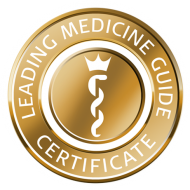In the case of a pulmonary embolism, a sudden occlusion of a pulmonary artery occurs. In the vast majority of cases, the causative embolus (entrained particle) is a blood clot. These blood clots usually originate from a thrombosis of the deep veins in the legs. Depending on the size of the clot, a pulmonary embolism can be asymptomatic (without any symptoms) or severe. Signs of a severe progression are pain in the chest area, shortness of breath, and even circulatory collapse.
If a bilateral pulmonary embolism occurs, the patient’s life is in the utmost danger. In Germany alone, for example, 7,000 German citizens die of pulmonary embolisms every year. Elderly people between 80 and 85 years of age are particularly affected. There is also a greater risk of an embolism during pregnancy or by taking the birth control pill in combination with nicotine abuse.
The difference between a thrombosis and an embolism is the following:
- Thrombus: A blood clot continues to grow and eventually leads to the occlusion of the blood vessel at this site (thrombosis)
- Embolus: A particle that travels through the bloodstream to other parts of the body and occludes a vessel there (embolism). The entrained particles may be blood clots, fat, air or, in rare cases, amniotic fluid.
Basically, this means that a thrombosis develops on the spot, usually in veins, but sometimes also in pre-damaged arteries. An embolism refers to a process that originates elsewhere and leads to the entrainment of particles (embolus) with the bloodstream.

A blood clot occludes a blood vessel (pathologically narrowed in this case)
Pulmonary embolisms are usually caused by thrombosis in the deep veins of the legs. Parts of the thrombosis are then transported with the blood flow from the leg to the right side of the heart and from there to the lungs. The embolus in this case is therefore the thrombosis or clots that detach from it. This is also referred to as a thromboembolism. Depending on the size of the detached clot, the symptoms of a pulmonary embolism may be very pronounced or may be almost nonexistent.
Yes, in rare cases, for example, a fat embolism can occur during birth due to an amniotic fluid embolism or in the course of a major bone fracture surgery. However, these forms of embolism are the exception. In the vast majority of cases, the embolism is the entrainment of blood clots (thromboembolism).
In general, a distinction is made between a:
- Solid embolus: transported blood clots, parasites, or tissue fragments. They cause of about 90 percent of all embolisms.
- Gaseous embolus, for example, air bubbles that develop after open vascular injuries
- Liquid embolus such as fat droplets from destroyed body tissue or amniotic fluid that penetrate into the vessels after bone fractures (fat) or through the process of childbirth (amniotic fluid)
Various risk factors can increase the likelihood of developing a thrombus and thus a pulmonary embolism as a possible consequence. These include, above all:
- Longer car or air travel,
- Surgical interventions,
- Restrictions in movement,
- Smoking,
- Hormone replacement therapies, and
- Being overweight.
For this reason, high-risk patients are advised to wear medical compression stockings when traveling for a long time and, if necessary, to receive a "thrombosis injection". In addition, breaks should be taken again and again to be able to move and activate the muscle pump.
A pulmonary embolism becomes noticeable through various signs. The nature of the symptoms depends on the extent of the entrained blood clot. The exact area of vascular occlusion also plays a role. Thus, minor pulmonary embolisms sometimes cause no symptoms at all. If, on the other hand, a larger pulmonary vessel is affected, this has a significant impact on the blood flow between the heart and the lungs, causing sudden discomfort. In the worst case, even a life-threatening cardiac arrest is possible.

© sasinparaksa / Fotolia
Typical symptoms of pulmonary embolisms are:
- Acceleration of breathing,
- Rapid heartbeat,
- Shortness of breath,
- Chest pain,
- A feeling of anxiety,
- Fear,
- Sweating,
- Fainting, and
- A drop in blood pressure and circulatory shock.
During the examination, the physician first takes the patient's medical history. In doing so, the doctor enquires about the nature of the symptoms as well as possible risk factors. A physical exam is also performed.
The so-called Wells’ criteria play an important role in the diagnosis. This is a point system named after the physician Philip S. Wells. It includes seven parameters:
- Is there evidence of deep vein thrombosis?
- Is the heart beating more than a hundred times a minute?
- Did the patient recently undergo surgery or have to be confined to bed?
- Has the patient ever suffered from a blood clot or a pulmonary embolism before?
- Does the patient cough up blood or does blood appear in the throat?
- Is the patient suffering from cancer?
- Are any other diagnoses likely?
One point is awarded per question. If other diagnoses are likely, then two points are deducted. From a value of two, a thrombosis or a pulmonary embolism is considered probable.
Treatment of pulmonary embolisms depends on their severity. The first step is to stabilize breathing and circulation. The doctor also administers a blood-thinning medication.
In the event of a severe pulmonary embolism resulting in circulatory collapse, rapid life support measures are required. This includes a cardiac massage and the delivery of pure oxygen through a nasal tube. Medication and fluid are administered through a vein. Further treatment takes place in the intensive care unit.
High-risk groups can prevent the development of pulmonary embolisms. This includes, for example, taking blood-thinning medications such as coumarins. Another important measure is the long-term use of medical compression stockings. These counteract the accumulation of blood in the legs and thus the formation of thrombi.
























